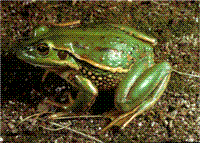Family
HylidaeGenus
LitoriaSpecies
casteneaThreats/Control Methods - Regional
The species is currently thought to be extinct and there are several possible factors thought to have led onto its demise including; predation by introduced fish such as Gambusia holbrooki, and loss of habitat, increased UV rays, diseases such as the Chytrid Fungus and drought. For more information on the Chytrid fungus © Link to fact sheet http://www.deh.gov.au/biodiversity/invasive/publications/c-disease/
Frogs drink and breathe through their skin and are very sensitive to chemicals in their environment. Where possible, you should not handle frogs, as the natural bacteria on your hands or chemicals such as sunscreen can damage their skin and cause illness or death.
Local/Urban Actions
Currently a recovery plan, under the title Yellow-spotted Bell Frog (Litoria castanea) and Peppered Tree Frog (Litoria piperata) Recovery Plan exists and has been adopted by the Department of Environment and Heritage. Threats such as those listed above are not unique to the Tablelands Bell Frog and continue to the threaten the survival of other frog species occurring within the ACT. Although the impact of feral animals may take considerable time to minimise it is possible to help frog species that occur naturally in your region, but are now experiencing losses in habitat due to increased urbanisation throughout the ACT. Urban backyards can become frog friendly habitats attracting numerous frog species helping to provide new habitats where old ones have been lost.Environment ACT has fact-sheets with information and tips on how to convert urban backyards to frog friendly landscapes. [Link - Creating a Frog Friendly Habitat in the ACT Community] .
Frog monitoring, under the Frogwatch Program, is run annually within the ACT, with monitoring done by volunteers from the general public over a two week period. The Frogwatch program provides training for community volunteers each October.
For more information on Frogwatch contact:The ACT Frogwatch Coordinator, Ginninderra Catchment Group; Ph(02)62783309 or email: [email protected]
Distinguishing Features
The body is mainly green with gold-brown mottling over across the back, and a lumpy wart-like texture, the belly is a pale cream colour. Although very similar in appearance to the Southern Bell Frog (Litoria raniformis ) and the Greena and Golden Bell Frog (Litoria aurea ), this species can be distinguished by the presence of full webbing between the toes, as well as black and yellow marbling on the inside leg makings. As with the appearance, the call of the Tablelands Bell Frog is very similar to these two frogs. In general the call is described as a being very similar to that of a motor bike, with the Tablelands Bell Frog lacking the prolonged growls found in the calls of the other two.
Common name/s
Tablelands Bell Frog, Yellow Spotted Tree Frog, Spotted-Thigh Bell Frog, New England Swamp Frog
Similar Species
Booroolong Frog (Litoria booroolongensis), Rocky Stream Frog (Litoria lesueuri), Southern Leaf-Green Tree Frog (Litoria nudidigitus), Spotted Tree Frog (Litoria spenceri), Peron©s Tree Frog (Litoria peronii), Whistling Tree Frog ( Litoria verreauxii verreauxii), Green and Golden Bell Frog (Litoria auera), Broad-palmed Frog (Litoria latopalmata), Southern Bell Frog (Litoria raniformis).
Distribution
The species has not been detected in the wild since the early 1970©s and is thought to be extinct, although an unconfirmed sighting was made as recently as 1991 in Armidale. Previously populations have been recorded within the New England Tableland, but were limited to small regions with an altitude of 1000-1500m AHD. Populations also existed in the South Eastern Highlands, from Lake George south to Bombala, at altitude ranging from 700-800m AHD. Populations near Orange and Bathurst were also suspected.
Country of Origin
Australia
Survey Techniques
Call identification is by far the easiest way to locate the presence and identification of frogs.
Conservation (Pet/Pest) Status - National
The species is listed as endangered under Wildlife Australia©s The Action plan for Australian Frogs, the Threatened Species Conservation Act 1995 and the Commonwealth Environment Protection Conservation Act 1999.Also Listed as critically endangered under the IUCN©s Red List.
Associated Vegetation Community
Associated plant species include Reeds [Phragmites spp.] and rushes [Juncu spp.]. Associated communities include dune swamps, coastal forests as well as other permanent slow moving water bodies.Limiting Resources: The species requires permanent water bodies.
Breeding
Although the ecology of the species is not fully know, it has been assumed that this species breeds at similar times of year to the other Bell Frogs, [Litoria raniormis]and [Litoria aurea], this being in the warmer months from August through to January.
Behaviour
As with the other Bell Frogs, L. raniormis and L. aurea , this species can be found indulging in the occasional sunbaking session resting on floating vegetation or a grassy bank. Breeding occurs in still or slow moving water bodies.
Functional Group
Insectivore
Food Species
Small invertebrates.
Predators
The Plague Minnow (Gambusia holbrooki).
Interesting Fact
It is possible that over zealous sampling and collection of the species in the New England Tablelands may have also played a role in the decline of the species.
References - (reader suitability of references, P=Primary teachers, S=Secondary students, T=Tertiary students and researchers)
Journals:
Heatwole, H. et al. (1995.). Faunal Survery of New England. I.V. the Frogs. Memoirs of the Queensland Museum. 38(1):229-249. S, T.
White,A, and Pyke,G. (1999.). Past Distribution of Litoria aurea and Litoria castanea in the Bathurst-Orange are of New South Wales. Herpetofauna.29(1):2-9. S, T.
Online Publications:
Department of Environment and Heritage. Recovery Plans Made or Adopted: under the Environment Protection and Biodiversity Conservation Act 199912 April 2006. Accessed 1 July 2006. Available online:
www.deh.gov.au/biodiversity/threatened/recovery/list-scientific.html S, T
Frogs Australia Network. Litoria castenea. Accessed 1 July 2006. Available online:
http://frogsaustralia.net.au/frogs/display.cfm?frog_id=138 P,S
Researcher: Pippa Jaminon

 Top
Top Top
Top